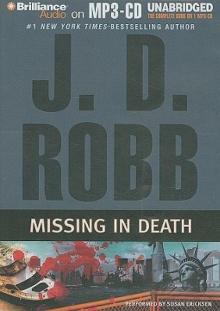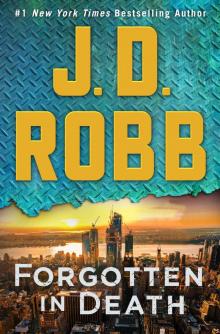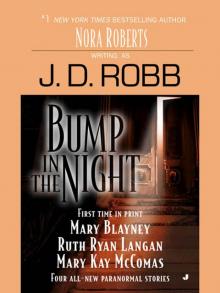- Home
- J. D. Robb
Concealed in Death Page 2
Concealed in Death Read online
Page 2
She walked over to where Peabody finished up with Nina.
“I’m sorry I’m not more help. This is so upsetting. I’ve never seen . . .” Nina glanced over to the open wall, away again. “I didn’t even see clearly really, but . . .”
“Did you examine the walls, the floors,” Eve began, “when you got the job?”
“We did several walk-throughs, of course. Measurements. Roarke’s directive was to gut the building, and to design spaces within the shell. We have all the blueprints and specs—architectural, engineering, mechanical. The bones—” She broke off, paled. “That is to say the shell, the structure is very sound, but the interior isn’t. It contains a lot of cheap material, a lot of poor design, quick fixes that were done over several decades, all leading to a number of years of neglect.”
“How many years of neglect?”
“Our research indicates the building hasn’t been used, officially, for about fifteen years. I did research some of its history, just to give me some background for the new design.”
“Send me what you’ve got. You’re free to go now. Do you have transportation?”
“I can get a cab. I’m fine. I’m not usually so . . . delicate. Can I speak with Roarke a moment before I leave?”
“Sure.” Eve shifted her attention to Peabody. “I think they’re kids.”
“Aw, shit, Dallas.”
“Not a hundred percent, but that’s my initial take. I need you to take Roarke’s statement, it’s just less sticky that way. I’ll take the job boss.” She looked over as the first of the sweepers came in the big iron door. “In a minute.”
With little more to do than direct, Eve set the sweepers to work, took Pete’s brief but colorful statement, then moved back to Roarke.
“The best thing you can do is find out everything you can about who and what and where and when regarding this building in the past fifteen years.”
“You think that’s when they were put there.”
“If the place hasn’t been used, or rarely, in that time, my best guess is, yeah, it’s going to be sometime between then and now. Now, allowing time for the decomp. If you can get me data on that, and another ream of data detailing, say, the five years before that, we may have something to play on.”
“Then you’ll have it.”
“What’s that over there? Where that portion of the wall’s removed.”
“That would be the previous owners, taking a look at the old wiring. There’s a similar break on the second level where they poked at the plumbing.”
“Too bad they didn’t hit this spot. We’d have found the remains sooner and you’d have got it cheaper.”
“It was cheap enough. Getting an actual inspection of the wiring and plumbing’s what put them in a mad scramble for more financing, or some backers. Neither of which they managed.”
“And you came along, swooped it up.”
“More or less. It and everything in it.”
She understood how he felt. “I can pretty much guarantee you didn’t own this place when they were put there. You found them, and they needed to be found. You can’t do anything here, Roarke. You should go, deal with the ten thousand meetings you’ve probably got on your schedule for the day.”
“Only a couple thousand today, so I think I’ll stay a bit longer.” He watched two of the sweepers in their white suits and booties run scanners over another wall.
“Okay, but I’ve got—” Eve broke off when the door screamed open again.
The woman who walked in might have been stepping onto a vid set. She wore a long sweep of coat in popping red, a flowing scarf that bled that red into silvery grays. A sassy red beret topped a short, sleek wedge of black hair. Gray boots with high skinny heels ran up under the hem of the coat.
She pulled off a pair of red-framed sunshades and revealed iced blue eyes that made an exotic contrast with smooth caramel skin. She tucked the shades into a gray bag the size of Pluto, took out a ’link with an ornate protective cover, and began to record the scene.
“Who the hell is that?” In quick strides, Eve crossed the dusty space. Some reporter, she thought, trying for a scoop. “This is a crime scene,” she began.
“Right, yes. I find it helpful to have a clear record of the environment. Dr. Garnet DeWinter.” She stuck out a hand, gripped Eve’s, gave it two firm shakes. “Forensic anthropologist.”
“I don’t know you. Where’s Frank Beesum?”
“Frank retired last month, moved to Boca. I took over his position.” She gave Eve a long, steady study. “I don’t know you either.”
“Lieutenant Dallas.” Eve tapped the badge she’d hooked to her belt. “I need to see your ID, Dr. DeWinter.”
“All right.” She reached into the bag Eve speculated could hold a small pony, drew out her credentials. “I was told you have skeletal remains. Two.”
“That’s right.” Eve handed the credentials back. “Wrapped in plastic, which was compromised, I believe, by vermin. They were discovered as demolition began, with that wall.”
She gestured, then led DeWinter over.
“Now, you I know.” DeWinter’s vid star face lit on Roarke’s. “Do you remember me?”
“Garnet DeWinter.” To Eve’s surprise, he leaned down, kissed both her cheeks. “It’s been five years, six?”
“Yes, six, I think. I read you’d married.” DeWinter spread her smile over him, and Eve. “Congratulations to both of you. I certainly didn’t expect to see you here, Roarke.”
“He owns the building,” Eve told her.
“Ah, bad luck.” She looked up, around, down. “It’s kind of a wreck, isn’t it? But you’re a genius at transformations.”
“As you are on bones. We’re fortunate to have her, Eve. Garnet is one of the top forensic anthropologists in the country.”
“‘One of’?” DeWinter said, and laughed. “I found myself unsatisfied in the lab in The Foundry in East Washington, so I jumped at the chance to take the position here, have a more hands-on opportunity. And I thought it would be a good change for Miranda—my daughter,” she said to Eve.
“Great, good. Maybe we can all catch up later over drinks and beer nuts, and I don’t know, maybe you’d like to take a look at the remains. Just for something to do.”
“Sarcasm. Ouch.” Undaunted, DeWinter swept off her coat. “Would you mind?” she asked, handing it to Roarke. “Through there?” At Eve’s nod, she moved to the opening, once again used her ’link to record.
“I have a record,” Eve began.
“I like my own. You opened the plastic wrapping on the top remains.”
“After a full record.”
“Still.”
“You’re not sealed,” Eve said when DeWinter started to step through.
“You’re right, of course. I’m still getting used to the protocols.” Out of the bag she pulled a white sweepers suit. She unzipped her boots, slid them off, then pulled the suit over her trim black dress. Then she took out a can of Seal-It, coated her hands.
She took the bag with her through the hole.
“Friend of yours?” Eve murmured to Roarke.
“Acquaintance, but she makes an impression.”
“You got that right,” Eve said and went through the hole.
“The remains on top—”
“Victim Two.”
“All right, Victim Two appears to be approximately 1.5 meters in length.”
“Just barely over, I did the measurement. Victim One is nearly the same, just under that.”
“Don’t take offense, but I’ll just remeasure, for my own record.” Once she had, DeWinter nodded. “From on-site visuals of the skull shape, the pubic area, Victim Two is female, between twelve and fifteen years. Most probably Caucasian. I see no outward sign of trauma. The crack in the right humerus, just above the elbow, indicat
es a break. Most likely between the ages of two and three. It didn’t heal well. There’s also a fracture of the right index finger.”
“Looks like more a twist than a break.”
“Agreed. Good eye. As if someone grabbed the finger, twisted it until it snapped.”
DeWinter drew out microgoggles, slipped them on, tapped them, and a light focused down. “She had a few cavities, and her twelve-year molars were through. A tooth missing. I also see some damage to the eye socket, left. An old injury.”
Slowly, systematically, DeWinter worked her way down the body. “A rotator cuff injury. Again it looks like a wrenching injury—someone grabbing the arm, twisting forcibly. Another fracture here, looks like a hairline in the left ankle.”
“Abuse. That’s a pattern of physical abuse.”
“Agreed, but I’ll want to study these injuries in my lab.”
She glanced up at Eve, her eyes huge behind the goggles. “I’ll be able to tell you more once I have her there. I need to move her to examine Victim One’s remains.”
“Peabody!”
Peabody popped into the doorway. “Sir!”
“Help me lift these remains.”
“Carefully,” DeWinter warned. “If you could take them out, and have Dawson secure them for transport. Do you know Dawson?”
“Yeah. Let’s get her up and out, Peabody.”
“Poor kid,” Peabody murmured, then gripped the plastic, lifted it with Eve like a hammock. “Who’s the fashion plate?” Peabody asked under her breath when they’d moved the remains into the main room.
“New forensic anthro. Dawson!”
When the head sweeper glanced her way, she signaled him. “Tell him to secure and arrange for transport,” Eve ordered Peabody, and went back through to rejoin DeWinter.
“In the same age range as the other. With the skull characteristics, I believe mixed race. Most likely Asian and black. Two strains of my heritage as well. Again no outward sign of trauma. A clean break in the tibia, healed well.”
DeWinter moved slowly, carefully along the remains. “I see no other breaks or injuries. All of the injuries, on One and Two, show they’d healed, and none were COD or incurred near TOD.”
As DeWinter’s light shone, Eve caught a quick sparkle.
“Wait.” She crouched, peered down through the eye socket of the skull. “There’s something here.” Grabbing a tool out of her kit, she reached through, clamped the tiny glitter.
“Excellent eye, indeed,” DeWinter said. “I missed it.”
“An earring.”
“I think a nose ring, possible brow ring. It’s a very small stud, so I’d lean toward the nose. It simply dropped off and down during decomp.”
Eve slid it into an evidence bag, sealed it.
“We’ll begin drawing out DNA, starting facial reconstruction. I assume you want ID as soon as we can possibly determine.”
“You assume right.”
“Cause and time of death may take longer. I could use a detailed history of the building, when the outer wall was constructed, what its purposes were.”
“Already being accumulated.”
“Excellent. Dawson can secure these remains as well. I’ll start on them immediately, and contact you as soon as I have anything useful. I look forward to working with you, Lieutenant.”
Eve took the offered hand again, then let it go when she heard the shout.
“We’ve got another one!”
She met DeWinter’s eyes. “Looks like you’re not done here yet.”
“Nor you.”
Before they were done, they found twelve.
Eve went through the building section by section. To the south wall first, where sweepers meticulously cut out a large square of gyp board, bagging some of its dust and chunks for analysis. Inside the narrow opening, three wrapped remains were stacked. She examined them along with DeWinter.
Females, between twelve and sixteen. As with the first two, some showed older injuries, none showed overt trauma that could be determined as cause of death.
With the remains, Eve found three studs and one small silver hoop.
The rest of the main floor held a handful of partitions, two small restrooms, long since stripped of fixtures.
By the time she, along with DeWinter, climbed the open iron stairs to the second level, the sweepers had found five more.
“Again we have a mix of ethnicity,” DeWinter told her, “and again, all female, all in the same age range. Some injuries I’d suspect resulted from childhood abuse, but none that determine cause of death. Whoever did this preyed on females past puberty, but far short of adulthood. Females of this age range, some of whom most likely experienced earlier physical abuse.”
“It was, for a few years, a kind of shelter.”
Eve glanced back at Roarke as she bagged what she thought might be a toe ring.
“What kind of shelter?”
“Documentation’s spotty. It was used as a kind of shelter for children and teenagers during the Urban Wars, those who’d lost their parents. A kind of makeshift orphanage.”
“These bodies haven’t been here since the Urbans.”
“It’s possible,” DeWinter disagreed. “I’ll be able to determine how long, within a reasonable time frame, once I have the remains back in my lab.”
“Not since the Urbans,” Eve repeated. “The concealing wall wasn’t built that long ago. And there would’ve been no need to keep them here like this. People died in droves during the Urbans. You want to kill a few girls, need to get rid of the bodies? Just take them out, leave them on the street. And,” she continued before DeWinter could speak again, “how the hell do you kill them, wrap them up, stack them up, then build walls to hide them when the place is full of people? You need time, you need some privacy.”
“Yes, I see you’re right. I only meant, forensically, the remains could be from that time period, and we won’t know until tests are run to determine.”
Eve straightened, handed the evidence bags out to Peabody. “Any documentation on how long the place housed Urban orphans?”
“I’m working on it,” Roarke told her. “This level and the one above were converted into dormitories, loosely. There were two communal baths, second floor, third floor.”
“Best I can figure,” Pete put in, “they went up toward the end of the Urbans, or right after. That’s going by material, and most of what was in them’s long gone. Nobody bothered with permits, inspections, codes back around then. What I can see of the plumbing that’s left, the wiring and basic infrastructure looks like it was scavenged, cobbled together. Same with the kitchen on the first floor, the two johns downstairs.”
“No upgrades?”
“Ah.” He scratched his head. “Some patchwork, some jury-rigging here and there. Done on the cheap. It’s why we didn’t think squat-all about the walls. We could see they weren’t part of the original structure, but it’s had a lot of half-ass fiddling over the years.”
“Dorms.” Stepping out, Eve surveyed the big, open space, imagined it crammed with cots and narrow beds, cheap, boxlike dressers or chests for belongings.
She’d lived through the experience of a state-run dorm—housing for disadvantaged, disenfranchised, and troubled kids. She supposed she’d been all three. But remembered, most of all, the days and nights of misery.
“You could fit twenty, twenty-five in here, double with bunks.”
“Be tight,” Pete commented.
“These kinds of places always run tight, and usually run cheap.”
She walked out, leaving DeWinter to her exam, studied the space across a narrow hall.
“Another dorm, maybe,” Pete suggested.
No, she thought, probably the “group” room, where you had to go for talk therapy, to listen to lectures, to receive duties or assignments. More mi
sery.
She walked down into what had been the communal bathroom for the floor.
And flashed clearly back to the one she’d dealt with.
Room for six stalls, maybe seven in a pinch, she decided. One tub, considered a privilege, open showers, maybe three showerheads that offered a piss-trickle on a good day, three sinks.
She tuned back in, heard Pete’s rambling voice.
“Stripped the old copper clean out, but you expect that. Helped themselves to some of the plastic pipes. Punched some holes in the old walls to get to it. Hauled out the johns, the tub. Had to be a tub over there, from what I can see of the rough plumbing. Mostly the same as this in the one on the third floor.”
“Girls on one level, boys on the other, most likely. Especially if there were teenagers.” At least that fit with her experience.
“Lieutenant.” Dawson walked to her, his face drawn now. “We found more.”
So there were twelve, wrapped, stacked, and hidden between walls. Some with a glitter or two among the bones to speak of the life once lived.
When she’d done all she could do, she stood out on the sidewalk with Roarke. The cold, the noise, the rush of life blew away some of the film, gyp dust and death, that seemed to cling to her face, her mind.
“We’re heading into Central. Any data you can find on the place, the time lines, owners, usage, send it—however minuscule. We’ll springboard off it, find more.”
“I’ve copied what I do have to your units, including the sellers.” He watched the way she studied the building. “You don’t like leaving them to DeWinter—your dead.”
“She’s the expert. And no,” Eve admitted, “I don’t. But I can’t look at their bones and figure out what happened to them. She can. Or I have to hope she can.”
“She’s very skilled. Will she work with Morris?”
Eve thought of the chief medical examiner, another who was very skilled. And one she trusted completely. “Yeah, she will. I’ll make sure of it. Twelve,” she mused. “In four different hidey-holes on three floors. Why spread them out? That’s a question. All the same basic types, but with a spread over racial lines. But height, age, all close. Maybe body type, too. Sloppy enough, or just didn’t care enough to remove all the body adornments.

 Concealed in Death
Concealed in Death Survivor in Death
Survivor in Death Born in Death
Born in Death Ceremony in Death
Ceremony in Death Indulgence in Death
Indulgence in Death Leverage in Death
Leverage in Death Devoted in Death
Devoted in Death Conspiracy in Death
Conspiracy in Death Holiday in Death
Holiday in Death The Unquiet
The Unquiet Naked in Death
Naked in Death Secrets in Death
Secrets in Death Seduction in Death
Seduction in Death Strangers in Death
Strangers in Death Creation in Death
Creation in Death Dark in Death
Dark in Death Possession in Death
Possession in Death Visions in Death
Visions in Death Midnight in Death
Midnight in Death Innocent in Death
Innocent in Death Vengeance in Death
Vengeance in Death Thankless in Death
Thankless in Death Glory in Death
Glory in Death Rapture in Death
Rapture in Death Echoes in Death
Echoes in Death Betrayal in Death
Betrayal in Death Celebrity in Death
Celebrity in Death Immortal in Death
Immortal in Death Judgment in Death
Judgment in Death Ritual in Death
Ritual in Death Portrait in Death
Portrait in Death Treachery in Death
Treachery in Death Brotherhood in Death
Brotherhood in Death Reunion in Death
Reunion in Death Connections in Death: An Eve Dallas Novel
Connections in Death: An Eve Dallas Novel Imitation in Death
Imitation in Death New York to Dallas
New York to Dallas Loyalty in Death
Loyalty in Death Witness in Death
Witness in Death Connections in Death
Connections in Death Divided in Death
Divided in Death Obsession in Death
Obsession in Death Purity in Death
Purity in Death Festive in Death
Festive in Death Missing in Death
Missing in Death Faithless in Death: An Eve Dallas Thriller (Book 52)
Faithless in Death: An Eve Dallas Thriller (Book 52) Golden in Death
Golden in Death The In Death Christmas Collection
The In Death Christmas Collection Forgotten in Death
Forgotten in Death Calculated in Death
Calculated in Death Salvation in Death
Salvation in Death Interlude in Death
Interlude in Death Haunted in Death
Haunted in Death Promises in Death
Promises in Death In Death 07.5 - Midnight in Death
In Death 07.5 - Midnight in Death 44 Delusion in Death
44 Delusion in Death Bump in the Night
Bump in the Night The In Death Collection, Books 16-20
The In Death Collection, Books 16-20![[In Death 17] - Imitation in Death Read online](http://i1.bookreadfree.com/i/03/20/in_death_17_-_imitation_in_death_preview.jpg) [In Death 17] - Imitation in Death
[In Death 17] - Imitation in Death In Death 06 - Vengeance in Death
In Death 06 - Vengeance in Death Dead Of Night
Dead Of Night In Death 10 - Witness in Death
In Death 10 - Witness in Death![[In Death 16] - Portrait in Death Read online](http://i1.bookreadfree.com/i1/03/27/in_death_16_-_portrait_in_death_preview.jpg) [In Death 16] - Portrait in Death
[In Death 16] - Portrait in Death Possession in Death edahr-39
Possession in Death edahr-39 Remember When edahr-20
Remember When edahr-20 Big Jack
Big Jack Delusion in Death edahr-44
Delusion in Death edahr-44 Missing in Death edahr-36
Missing in Death edahr-36 Origin in Death edahr-24
Origin in Death edahr-24![[In Death 18] - Divided in Death Read online](http://i1.bookreadfree.com/i1/04/03/in_death_18_-_divided_in_death_preview.jpg) [In Death 18] - Divided in Death
[In Death 18] - Divided in Death The Lost
The Lost![[In Death 05] - Ceremony in Death Read online](http://i1.bookreadfree.com/i1/04/01/in_death_05_-_ceremony_in_death_preview.jpg) [In Death 05] - Ceremony in Death
[In Death 05] - Ceremony in Death In Death 09 - Loyalty in Death
In Death 09 - Loyalty in Death Chaos in Death edahr-42
Chaos in Death edahr-42 In Death 12.5 - Interlude in Death
In Death 12.5 - Interlude in Death![In Death [47] Leverage in Death Read online](http://i1.bookreadfree.com/i1/04/01/in_death_47_leverage_in_death_preview.jpg) In Death [47] Leverage in Death
In Death [47] Leverage in Death In Death - 24.50 - Dead of Night
In Death - 24.50 - Dead of Night Leverage in Death--An Eve Dallas Novel
Leverage in Death--An Eve Dallas Novel![[In Death 24] - Innocent in Death Read online](http://i1.bookreadfree.com/i1/04/05/in_death_24_-_innocent_in_death_preview.jpg) [In Death 24] - Innocent in Death
[In Death 24] - Innocent in Death![[In Death 15] - Purity in Death Read online](http://i1.bookreadfree.com/i1/04/05/in_death_15_-_purity_in_death_preview.jpg) [In Death 15] - Purity in Death
[In Death 15] - Purity in Death The In Death Collection, Books 26-29
The In Death Collection, Books 26-29 New York to Dallas edahr-41
New York to Dallas edahr-41 The Other Side
The Other Side The In Death Collection 06-10
The In Death Collection 06-10![[In Death 08] - Conspiracy in Death Read online](http://i1.bookreadfree.com/i2/04/05/in_death_08_-_conspiracy_in_death_preview.jpg) [In Death 08] - Conspiracy in Death
[In Death 08] - Conspiracy in Death The In Death Collection, Books 21-25
The In Death Collection, Books 21-25 Memory in Death edahr-25
Memory in Death edahr-25 The In Death Collection, Books 30-32
The In Death Collection, Books 30-32 Down the Rabbit Hole
Down the Rabbit Hole Leverage in Death: An Eve Dallas Novel (In Death, Book 47)
Leverage in Death: An Eve Dallas Novel (In Death, Book 47) The In Death Collection, Books 6-10
The In Death Collection, Books 6-10 The In Death Collection, Books 11-15
The In Death Collection, Books 11-15 Celebrity in Death edahr-43
Celebrity in Death edahr-43 Treachery in Death edahr-40
Treachery in Death edahr-40![[In Death 12] - Betrayal in Death Read online](http://i1.bookreadfree.com/i2/04/13/in_death_12_-_betrayal_in_death_preview.jpg) [In Death 12] - Betrayal in Death
[In Death 12] - Betrayal in Death The In Death Collection, Books 1-5
The In Death Collection, Books 1-5